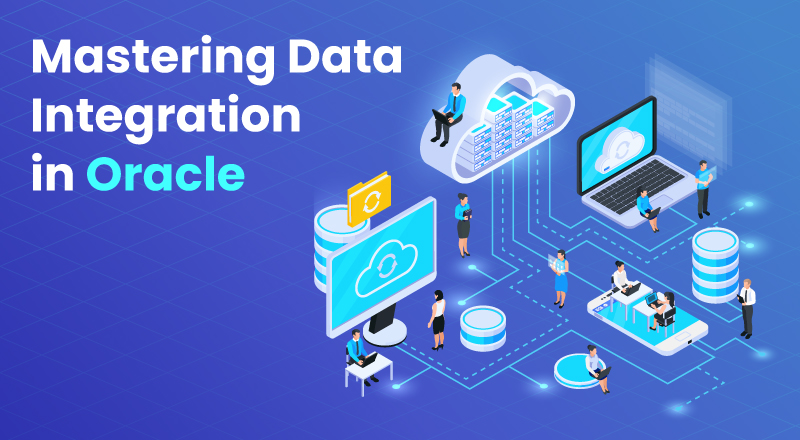

In today’s data-driven world, organizations rely on data from various sources to make informed decisions, gain insights, and stay competitive. However, managing data from disparate sources can be challenging. This is where data integration comes into play, and Oracle offers a robust set of tools and technologies to facilitate this process.
Oracle steps into the scene with a comprehensive suite of tools and cutting-edge technologies designed to simplify data integration. Join me on this blog journey as we delve into the significance of data integration in Oracle, understand its importance, and even walk through a hands-on example. In this blog, we’ll explore data integration in Oracle, it’s importance, and provide a hands-on example.

Data integration is the process of combining data from different sources, transforming it into a unified format, and loading it into a target system for analysis, reporting, or other business purposes. Oracle provides a comprehensive suite of tools for data integration, making it easier for organizations to achieve seamless data flows.
Integrated data allows organizations to make data-driven decisions by providing a holistic view of their operations and customers.
Streamlining data integration processes can lead to more efficient operations, reducing manual data handling and errors.
Integrated data enables a better understanding of customer behavior, preferences, and needs, which can lead to improved customer experiences.
Organizations that can quickly integrate and analyze data gain a competitive edge by responding to market changes and trends faster.
Oracle provides several data integration tools to cater to different integration requirements:
Oracle Data Integrator is a comprehensive data integration platform that enables users to extract, transform, and load (ETL) data from diverse sources into Oracle databases or other target systems. ODI offers a visual development interface and supports both batch and real-time data integration.
Oracle GoldenGate is a real-time data replication and integration tool that allows organizations to capture and move data across heterogeneous systems with minimal latency. It supports various sources and targets, including Oracle databases, non-Oracle databases, and cloud platforms.
Oracle Integration Cloud provides cloud-based data integration services for connecting on-premises and cloud applications, automating business processes, and streamlining data flows. It simplifies data integration through pre-built adapters and a user-friendly interface.
Data quality is a critical aspect of data integration. Oracle’s EDQ tool helps organizations cleanse, standardize, and enrich data, ensuring that integrated data is accurate and reliable.
Data integration can be approached in two primary ways: ETL and ELT. Oracle Data Integrator (ODI) supports both of these styles, allowing organizations to choose the one that best aligns with their requirements.
In the ETL approach, data is first extracted from source systems, then transformed into the desired format within a dedicated transformation layer, and finally loaded into the target system. This approach is typically used when:
Oracle Data Integrator’s ETL capabilities are well-suited for scenarios where data transformations are a significant part of the integration process. It provides a visual interface for designing complex data transformation logic and supports various transformation functions.
In the ELT approach, data is first extracted from source systems and loaded directly into the target system. Transformation is then performed within the target database itself, often using the native capabilities of the database or specialized tools. ELT is advantageous when:
Oracle Data Integrator’s ELT capabilities are a part of its broader data integration toolkit. It leverages the power of Oracle Database and Exadata for in-database transformations, offering high performance and scalability.
The choice between ETL and ELT should be based on your organization’s specific needs, including factors like data volume, complexity, latency requirements, and existing technology stack. Oracle Data Integrator’s support for both styles provides the flexibility to design data integration solutions that best fit your use case.
Intresting Reads: Business Intelligence Consultant: Roles, Responsibilities, Skills, And Scope
Data integration is a vital component of modern business operations, enabling organizations to harness the power of data for strategic decision-making. Oracle offers a comprehensive suite of tools and solutions to meet the data integration needs of enterprises, from ETL processes to real-time data replication and cloud-based integration services. By following best practices and leveraging Oracle’s technology stack, organizations can achieve efficient and reliable data integration, driving success in the data-driven era.
SPEC INDIA is your trusted partner for AI-driven software solutions, with proven expertise in digital transformation and innovative technology services. We deliver secure, reliable, and high-quality IT solutions to clients worldwide. As an ISO/IEC 27001:2022 certified company, we follow the highest standards for data security and quality. Our team applies proven project management methods, flexible engagement models, and modern infrastructure to deliver outstanding results. With skilled professionals and years of experience, we turn ideas into impactful solutions that drive business growth.
SPEC House, Parth Complex, Near Swastik Cross Roads, Navarangpura, Ahmedabad 380009, INDIA.
This website uses cookies to ensure you get the best experience on our website. Read Spec India’s Privacy Policy